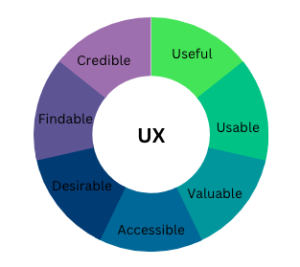User Experience
User Experience
Definition
The overall experience of users while using a product or service is defined as user experience.
Description
Brands can expect repeated purchase or multiple visits from a user only if their experience on the website or digital touchpoint is positive. It gained relevance because it improves product usability experiences.

The broad term of it explains how well the users can navigate the product or how beautifully the content is displayed. This is why it is called user-centred design (UCD).
It makes the journey fulfilling for the users so that they stick longer and stay loyal to the products and services. For a website, making the user’s journey seamlessly effortless, is important.
Every interaction at different touchpoints between the customer and the company is included when measuring the user experience.
Importance of user experience.
User experience is important because it:
- Makes navigation easier for the users on the website.
- Gives a positive experience that keeps the users loyal to the brand.
- Better word of mouth publicity for the brand.
- Repeat visits to the website for increased sales.
How to develop user experience?
These are the process in which you can develop user experience:
Step1: Create user profiles and personas:
In the first step, you can develop user personas that relate to voice and the emotions of the users. You can then create the content of the website around the same thoughts. Ultimately, you have the site that talks about what the users want. You can build personas around having these things in common-
- Demographics that are age, location, family status, and career.
- Personality which can be introvert or extrovert.
- Intent that can be around fear, power, authority-building, and incentivisation.
Step 2: Compare different interfaces to offer quality user experience:
Before finalising a design, you must compare various user interfaces and the user experiences it offers. A small CTA button can influence the effectiveness of the website which can keep the users on your website for long.
Step 3: Consider user surveys :
Conduct surveys to find how the target audience behave while they use your website. Does any element confuse them or do they find any element extra-ordinary.
Step 4: Evaluate based on the user flow diagram:
Make a user flow diagram to show how the user should move in the system. Now compare it with the way the users actually move through the website. After evaluating, you can actually find and make necessary changes to enhance it.
Step 5: Creating a sitemap:
A sitemap is a guide to tell how the user on a website moves from point A to point B. It also elaborates on how many clicks does the user complete the journey.
Step 6: Wireframes and Prototypes:
Wireframes are visual guides that give the framework of the web pages and give a preview of your site to show how it looks and feels. You can rectify development issues before hitting the final design.
Step 7: Style guides:
Style guides are indicative of making consistent content style across the website. It is important to maintain consistency to improve the UX of the website.
Example

Forbes is a business magazine that offers high-quality content that engages the user for a long time. But an unusually high number of banner ads and pop-ups make it difficult to read a whole article.
FAQs
What are the 7 factors that affect the user experience?
Seven factors that affect the UX include:
- Useful
- Usable
- Credible
- Valuable
- Accessible
- Desirable
- Findable
What are the types of user experience?
There are three types of UX:
- Interaction Design which focuses on how users interact with the product or services.
- Visual Design stresses on how the look and feel of the product appears.
- Information Architecture spells about how information is organised before it is presented to the users.
Difference between user experience and customer experience.
This is the difference between user experience and customer experience:
| User Experience | Customer Experience |
| User Experience (UX) is the study of how users engage with your product and what kind of experience they have as a result. | Customer experience talks about all interaction a person has with your brand. It defines the likelihood to use the brand. |
| Metrics like success rate, error rate, abandonment rate, time to finish task, and (since we deal in digital) clicks to completion are used to measure it. | Metrics like customer effort score, customer satisfaction, net promoter score, customer churn rate, customer referral rate, average resolution time, and first contact resolution are used to measure customer experience. |





We would love to have your opinion.